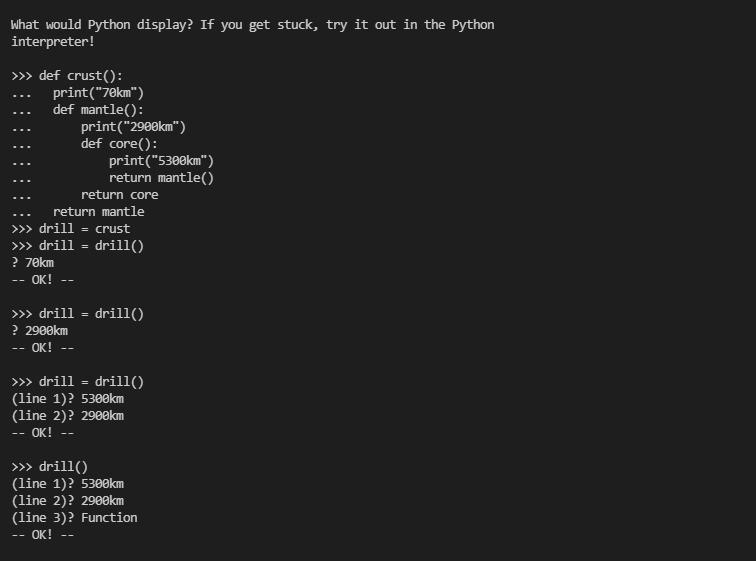cs61a 2021 fall lab04
网址 https://inst.eecs.berkeley.edu/~cs61a/fa21/lab/lab04/
question1:
简单理解递归就好了
这是一些测试用例

HW_SOURCE_FILE = __file__
def summation(n, term):
"""Return the sum of numbers 1 through n (including n) wíth term applied to each number.
Implement using recursion!
>>> summation(5, lambda x: x * x * x) # 1^3 + 2^3 + 3^3 + 4^3 + 5^3
225
>>> summation(9, lambda x: x + 1) # 2 + 3 + 4 + 5 + 6 + 7 + 8 + 9 + 10
54
>>> summation(5, lambda x: 2**x) # 2^1 + 2^2 + 2^3 + 2^4 + 2^5
62
>>> # Do not use while/for loops!
>>> from construct_check import check
>>> # ban iteration
>>> check(HW_SOURCE_FILE, 'summation',
... ['While', 'For'])
True
"""
assert n >= 1
"*** YOUR CODE HERE ***"
if n == 1:
return term(1)
else :
return term(n) + summation(n-1, term)
def pascal(row, column):
"""Returns the value of the item in Pascal's Triangle
whose position is specified by row and column.
>>> pascal(0, 0)
1
>>> pascal(0, 5) # Empty entry; outside of Pascal's Triangle
0
>>> pascal(3, 2) # Row 3 (1 3 3 1), Column 2
3
>>> pascal(4, 2) # Row 4 (1 4 6 4 1), Column 2
6
"""
"*** YOUR CODE HERE ***"
if column > row :
return 0
if column == 0:
return 1
return pascal(row - 1, column) + pascal(row - 1, column - 1)
def paths(m, n):
"""Return the number of paths from one corner of an
M by N grid to the opposite corner.
>>> paths(2, 2)
2
>>> paths(5, 7)
210
>>> paths(117, 1)
1
>>> paths(1, 157)
1
"""
"*** YOUR CODE HERE ***"
if m == 1 or n == 1:
return 1
return paths(m - 1, n) + paths(m, n - 1)
def couple(s, t):
"""Return a list of two-element lists in which the i-th element is [s[i], t[i]].
>>> a = [1, 2, 3]
>>> b = [4, 5, 6]
>>> couple(a, b)
[[1, 4], [2, 5], [3, 6]]
>>> c = ['c', 6]
>>> d = ['s', '1']
>>> couple(c, d)
[['c', 's'], [6, '1']]
"""
assert len(s) == len(t)
"*** YOUR CODE HERE ***"
for i in range(len(s)):
s[i] = [s[i], t[i]]
return s
def coords(fn, seq, lower, upper):
"""
>>> seq = [-4, -2, 0, 1, 3]
>>> fn = lambda x: x**2
>>> coords(fn, seq, 1, 9)
[[-2, 4], [1, 1], [3, 9]]
"""
"*** YOUR CODE HERE ***"
return [[x,fn(x)] for x in seq if lower <= fn(x) <= upper]
def riffle(deck):
"""Produces a single, perfect riffle shuffle of DECK, consisting of
DECK[0], DECK[M], DECK[1], DECK[M+1], ... where M is position of the
second half of the deck. Assume that len(DECK) is even.
>>> riffle([3, 4, 5, 6])
[3, 5, 4, 6]
>>> riffle(range(20))
[0, 10, 1, 11, 2, 12, 3, 13, 4, 14, 5, 15, 6, 16, 7, 17, 8, 18, 9, 19]
"""
"*** YOUR CODE HERE ***"
ans = []
even = 0
odd = int(len(deck) / 2)
for i in range(0,len(deck)):
if i % 2 == 0:
ans = ans + [deck[even]]
even += 1
else:
ans = ans + [deck[odd]]
odd += 1
return ans



 浙公网安备 33010602011771号
浙公网安备 33010602011771号